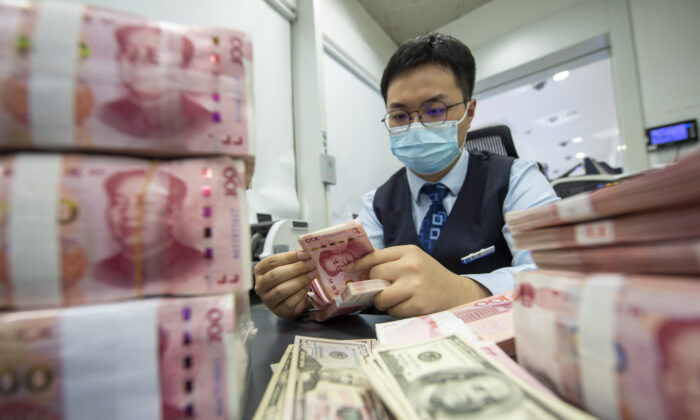The Chinese communist regime has issued approximately 4.2 trillion yuan ($585 billion) in local government bonds in the first 7 months of this year, with nearly half of them being refinancing bonds used to pay off old government debts, according to the latest data.
Statistics from the Chinese Communist Party’s Ministry of Finance reveal that in May alone, 903.6 billion yuan ($126 billion) in bonds were issued, marking the highest amount in a single month in the first half of the year.
Among the total 4.2 trillion yuan ($585 billion) in bonds, about 2 trillion yuan ($279 billion) was raised through the issuance of refinancing bonds, which are utilized to settle matured or existing debts.
Li Hengqing, a senior accountant and economist at the Institute for Information and Strategic Studies in the United States, highlighted on Aug. 8 that the 2 trillion yuan ($279 billion) refinancing bonds were primarily used to repay the interest incurred by the debt. China’s local government debt had reached 92 trillion yuan ($12.58 trillion) by late 2023.
“Repaying the interest alone costs more than 4 trillion yuan ($557 billion) a year; they have no money to repay the principal,” Li stated.
“This is the consequence of the insufficient ability of local governments to repay debts. From the CCP central government to local governments, their debt repayment capacity has drastically declined,” mentioned Yu Yaw-shun, assistant professor of Finance at Chung Hua University in Taiwan, in an interview with The Epoch Times on Aug. 8. The CCP is “borrowing new debt to pay off the old [debt].”
“[The CCP’s] external economic and energy expansion has been hindered by the Western world, which has already impacted the CCP’s finances. All local governments are now reliant on internal economic circulation,” he explained.
Out of the 2.2 trillion yuan ($307 billion) in new bonds, 1.8 trillion yuan ($251 billion) are new special bonds, and 0.4 trillion yuan ($55.7 billion) are new general bonds. The funds from the new special bonds were primarily invested in municipal and industrial park infrastructure, constituting around 34 percent of it—followed by investment in transportation infrastructure like railways, government toll roads, and rail transit, accounting for 20 percent, as per the data.
Special bond funds issued and utilized in the infrastructure sector in the first seven months of this year accounted for 68.2 percent of the total, which is 5.1 percentage points higher than the previous year.
Regarding the CCP’s high percentage of local infrastructure investment, Yu stated: “From 2022 to last year, all they had was the advancement of the state and the retreat of the private sector, and all foreign investments were gradually declining. Therefore, the CCP now solely relies on building infrastructure with cement, bridges, and steel beams because its AI and semiconductor industry have been blocked [by the West].”
Yu added that now, as the CCP can only depend on internal circulation, “the economic growth rate in most coastal provinces is declining. They rely on coastal provinces to invest in inland provinces, indicating that their internal circulation is facing significant challenges.”
According to the CCP’s budget report for this year, experts anticipate a significant increase in the issuance of local government bonds between August and October, reaching the peak for this year.
Huge Hidden Debt on LGFVs
Data from the CCP’s Ministry of Finance shows that by the end of December 2023, local government debt stood at 40 trillion yuan ($5.57 trillion). However, Goldman Sachs estimated in August 2023 that the accumulated debt of local governments was as high as 94 trillion yuan ($13 trillion), inclusive of the debt of local government financing vehicles (LGFVs), which is an off-balance sheet liability.
LGFVs are considered the “black hole” of China’s financial system by the industry. The International Monetary Fund estimated that China’s total debt held by LGFVs surged from 57 trillion yuan ($7.9 trillion) in 2022 to 66 trillion yuan ($9.1 trillion) in 2023. Most of the debt principal on LGFVs is rolled over by borrowing new debt, but the interest on the debt must be repaid.

Yu stated that the international financial agencies and institutions’ assessment of China’s debt is “a significant blow” to the Chinese regime. “Its refinancing debt and debt turnover have increased certain risks. Countries in the Western world are hesitant to continue investing, and China’s status as the world’s factory has gradually diminished. Taiwanese, Japanese, and other foreign companies have started to leave the country.”
Yu mentioned Foxconn as an example. The Taiwanese Apple supplier relocated its iPhone factories out of China in April as Apple shifted production to other countries.
“The financial strength of the central government is no longer sufficient, so how can local governments have the funds?” Yu questioned.
Li mentioned that the CCP’s substantial government debt and bond issuance have dragged Chinese banks into a debt crisis due to reduced liquidity. “This is actually a vicious circle. They are trapped in this vicious cycle. This is not something new. They have been doing it for many years, but now, this crisis has become more critical, and the time when it will collapse completely is drawing closer and closer.”
Luo Ya and Reuters contributed to this report.
Please rephrase this sentence.
Source link







